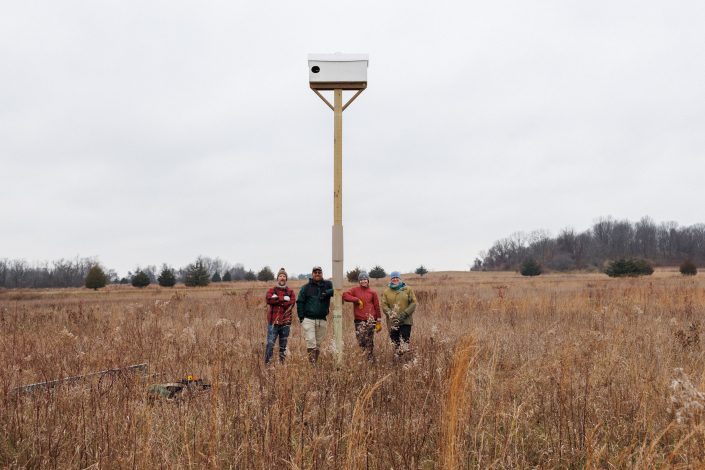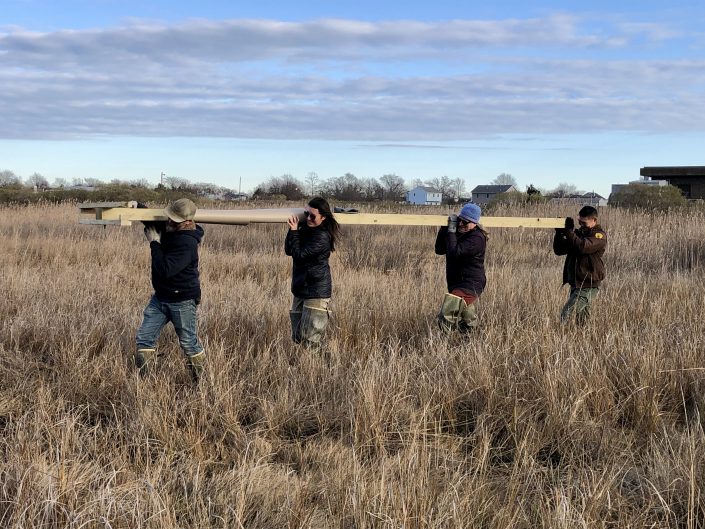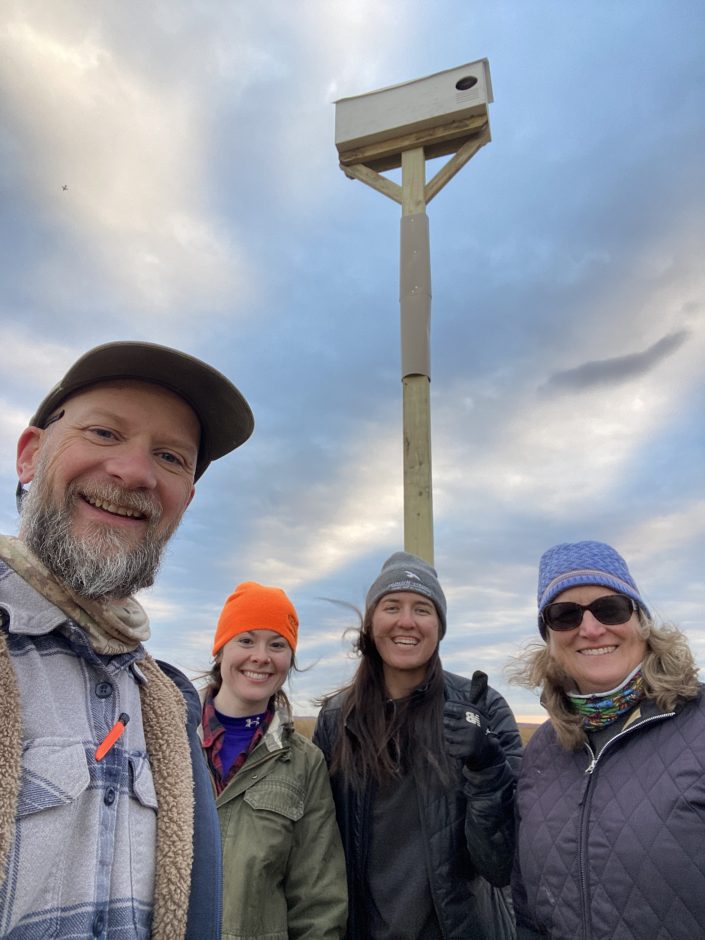Testing the “If you build it, [they] will come” Philosophy: A Case Study on Barn Owls in Monmouth County
In 2022, Conserve Wildlife Foundation was awarded a grant by the Monmouth County Audubon Society to establish artificial nesting areas for barn owls in field and salt marsh habitats within the county. Most of the barn owl activity recorded in New Jersey occurs in Salem and Cumberland counties, where population density and development are comparatively low. Though barn owls are sighted in Monmouth, there is no evidence of nesting activities at present. By providing boxes for owls in appropriate habitat types, we hope to encourage this to change. Our project proposal had 4 objectives:
- Select 3 locations suitable for nesting barn owls within Monmouth County.
- Construct owl boxes.
- Install boxes within chosen parks.
- Monitor for occupancy during the nesting season.
Former CWF biologist, Meghan Kolk, worked with the Monmouth County Parks System (MCPS) and the state to isolate promising locations with adequate features (open space for hunting rodents, distance from roads, etc.) to support nesting owls. In 2023, CWF biologist Christine and senior biologists Larissa and Ben took over the management of program deliverables.
Barn owls are the most widespread species of owl; they occur on all continents except Antarctica and span a multitude of habitat types including open fields, shrublands, savannas, and coastal marshes, among others. Given this vast geography, it may be unsurprising that approaches to their conservation, particularly where nest boxes are concerned, are as varied as their landscape. Sorting through design plans or available products can be overwhelming, though most organizations will agree on a few major elements that will increase usage and success.
First, barn owls, at ~16” tall, are relatively large birds. Females lay clutches of 4-6 eggs and the chicks remain in the nest box for ~55 days after hatching. According to the Barn Owl Trust, a satiated owlet’s weight can exceed that of its parents by 100 g by 6 weeks of age. All this to say, barn owl boxes are no small thing… For perspective, transporting three in a Subaru Forester with the seats down was a challenge. The owl’s size also influences the point of entry. A well-constructed box should have an opening that mimics a natural nesting cavity- providing a comfortably tight squeeze for the owl while excluding larger predators. The opening should be positioned high on the box to prevent the owlets from falling out. Painting the exterior white can help ensure appropriate thermal conditions and allows researchers to determine occupancy. Finally, barn owl feathers are adapted to enable near-silent flight which makes them less tolerant of the rain than other birds. The roofs of barn owl boxes should be reinforced with caulk (or hot glue) to provide some level of waterproofing.

Christine and her dad, Jim, assembled three boxes this past fall, as reported in a previous story. They utilized specs provided by the Barn Owl Research Institute, which have been used to good effect in New Jersey for over 40 years and utilize all the features listed above.
On December 7th, CWF installed the first box in Big Brook Park in Marlboro. As a veteran when it comes to this type of work, Ben instructed the team on the fundamentals of constructing a cantilevered base and ensured the box was nice and stable for future occupants as well as volunteers who will be responsible for replacing the pine mulch substrate each year. Prior to its purchase by the Monmouth County Parks System, Big Brook was a dairy farm and piggery. The back half of the park contains several large tree-lined fields which makes it a great candidate for rodent-loving barn owls.

We returned to Monmouth County on December 20th to install our remaining two boxes, this time in salt marsh environments. Bayshore Waterfront Park, part of the County Parks system was chosen as the first site. Located in Port Monmouth on Sandy Hook Bay, this spot was the most residential area chosen for this project. The most promising habitat occurred on associated land outside the main park so, in the event the box becomes occupied, the owls should remain undisturbed. Access required bushwhacking through tall phragmites and crossing multiple tidal ditches, which should help further discourage visitation. The final box was placed at Conaskonk Point in Union Beach- an area of state land managed by the Cheesequake Park rangers. Each installation took about 3 hours, so we were fighting for daylight during this last effort. The consistency of the sediment made it difficult to reach the recommended depth for the support beams but with a little ingenuity and upcycling of marsh debris, we got the job done before we lost the sun.

To reduce the amount of materials we needed to lug through the marshes, we chose to complete much of the post assembly near the truck, which attracted the attention of several landowners with properties bordering the habitat. We were very pleased that they all expressed excitement at the prospect of new avian neighbors!
Barn owl courtship and egg laying typically begins in March. During this time, they are very sensitive to disturbance and the risk of nest abandonment is high. We will keep our distance from the boxes until mid-May, at which point we would not expect the parents to leave their owlets. We can easily check for signs of occupancy by looking for scratches in the paint surrounding the entry hole. If the boxes are occupied, we will investigate the interior using a camera on a telescoping rod to minimize stress. We will return once more to band the chicks prior to fledging. If the boxes are unoccupied, we will visit again in the fall to ensure we are aware of any late-season activity. Stay tuned for further updates on this exciting project!
We are very grateful to the Monmouth County Parks staff, particularly park naturalist, Paul Mandala and environmental specialist, Rob Fanning for their assistance with site selection, permitting, and the installations at Big Brook and Bayshore Waterfront parks. We were also fortunate to have the help of Cheesequake superintendent, Jon Luk, during our efforts at Conaskonk Point, who also facilitated permissions with the state.
Special thanks to the Monmouth County Audubon Society for funding this project and to CWF biologist, Emmy Casper, who also helped with the marsh installs.

Discover more from Conserve Wildlife Foundation of NJ
Subscribe to get the latest posts sent to your email.
Leave a Comment
You guys are all rock stars!!! Keeping fingers crossed for good results!
Thanks so much for your kind words, Carol! We are hoping for some exciting developments this season.
So glad you are trying to help barn owl nesting success. I wonder about the number of silos in Burlington County which could be used by barn owls. Would love to see a project checking them out for access and nesting platforms.
Hope you spread the word to other county parks about your work. Maybe you can enlist those interested neighbors to keep an eye on the new boxes.
Thank you for all the time and effort you put into this project!
Hi Holly, Yes, there are probably more barn owls around than we know about, since they are a cryptic species. Doing some better outreach in rural areas (with farmland) would be a great first step to see where nestboxes could be placed to enhance habitat for them. Burlington County has some great habitat!
Comments are closed.